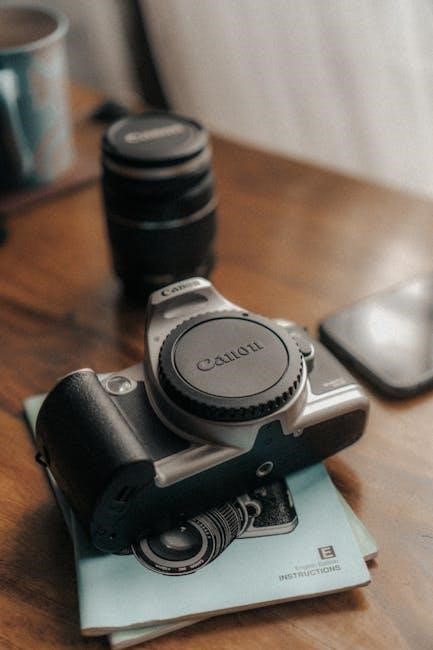
canon rebel t6 instruction manual
The Canon EOS Rebel T6 is an entry-level DSLR camera designed for beginners, offering an 18MP APS-C CMOS sensor and DIGIC 4 image processor for vibrant, detailed photos.
Its compact design, user-friendly interface, and robust features make it ideal for those transitioning from smartphones to DSLRs, ensuring high-quality imaging with intuitive controls.
The EOS Rebel T6 manual provides essential guidance, helping users master its capabilities, from basic settings to advanced techniques, ensuring optimal performance in various shooting conditions.
1.1 Overview of the Camera and Its Features
The Canon EOS Rebel T6 is an 18-megapixel APS-C DSLR camera designed for entry-level photographers. It features a DIGIC 4+ image processor, a 3-inch LCD screen, and HD video recording capabilities. The camera includes built-in Wi-Fi and NFC for wireless connectivity, along with a variety of shooting modes to suit different photography needs. It’s an excellent choice for beginners looking to explore creative photography.
1.2 Importance of the Instruction Manual
The instruction manual is essential for understanding the Canon EOS Rebel T6’s capabilities and optimizing its use. It provides detailed explanations of features, shooting modes, and customization options, helping users troubleshoot common issues and achieve better results. By following the manual, photographers can unlock the camera’s full potential and enhance their photography skills effectively.

Unboxing and First Impressions
The Canon EOS Rebel T6 arrives with essential accessories, including the camera body, lens, battery, charger, and strap. Initial setup involves installing the battery and memory card, providing a seamless start for beginners. The camera’s lightweight design and intuitive controls create a positive first impression, making it easy to navigate for new users.
2.1 What’s Included in the Box
The Canon EOS Rebel T6 box includes the camera body, EF-S 18-55mm lens, battery pack LP-E10, battery charger LC-E10, neck strap, eyecup, and instruction manual. Additional items like a USB cable and camera cover may vary by region. Ensure all components are present before setup. The battery and memory card are essential for initial operation, though a memory card is not included.
2.2 Initial Setup and Battery Installation
Start by charging the LP-E10 battery using the LC-E10 charger. Insert the battery into the camera’s bottom compartment, ensuring the terminals align correctly. Close the compartment door until it clicks. Next, insert a memory card into the slot on the side. Power on the camera to complete the initial setup. Follow on-screen prompts to set the language, date, and time.

Understanding the Camera Layout
The Canon EOS Rebel T6 features an ergonomic design with intuitive controls, ensuring easy access to key functions. Its layout enhances navigation and shooting efficiency for all photographers.
3.1 Key Features and Components
The Canon EOS Rebel T6 boasts an 18.0 MP CMOS sensor, DIGIC 4+ image processor, and a 3-inch LCD screen for previewing shots. It includes a built-in flash, optical viewfinder, and compatibility with EF-S lenses like the EF-S 18-55mm f/3.5-5.6 IS II. The top panel features a mode dial, main dial, and buttons for quick access to settings, while the rear includes navigation controls for easy menu adjustments.
3.2 Navigating the Camera’s Controls
The Canon EOS Rebel T6 features intuitive controls, starting with the mode dial on top for selecting shooting modes. The rear multi-controller navigates menus and selects autofocus points, while the quick control button provides instant access to settings like ISO and autofocus mode. The main dial adjusts shutter speed in manual mode and scrolls through menu options, streamlining operation for effortless control.

Basic Camera Operation
Learn the essentials of operating your Canon EOS Rebel T6, from turning it on to capturing your first shots. Master the mode dial, shutter button, and basic review functions for a seamless photography experience.
4.1 Inserting the Memory Card
To insert a memory card into your Canon EOS Rebel T6, turn off the camera for safety. Open the memory card compartment on the right side. Align the card with the slot, ensuring the label faces up, and gently push it in until it clicks. Use a compatible SD, SDHC, or SDXC card. Always format new cards in the camera before use.
4.2 Setting the Date and Time
To set the date and time on your Canon EOS Rebel T6, press the Menu button and navigate to the Setup menu using the directional buttons. Scroll down to the “Date/Time” option and press SET. Use the directional buttons to adjust the date and time, then press SET to confirm. Ensure the settings are correct for accurate photo metadata.
4.3 Basic Shooting Modes
The Canon EOS Rebel T6 offers several basic shooting modes, including Scene Intelligent Auto, Creative Auto, and the Flash Off mode. Scene Intelligent Auto automatically adjusts settings for optimal results, while Creative Auto allows basic adjustments like aperture and shutter speed. These modes simplify photography, enabling users to capture high-quality images with minimal manual adjustments.
Shooting Modes Explained
This section explores the Canon EOS Rebel T6’s shooting modes, helping users capture stunning images across various scenarios with tailored settings and options.
5.1 Auto Mode and Scene Intelligent Auto
The Canon EOS Rebel T6’s Auto Mode simplifies photography by automatically adjusting settings for optimal results. Scene Intelligent Auto further enhances this by analyzing the scene and refining settings for accurate exposure, color, and focus. These modes are ideal for beginners or quick shots, ensuring high-quality images with minimal effort. The camera handles all complexities, making it perfect for capturing portraits, landscapes, and everyday moments effortlessly.
5.2 Program AE, Manual, and Custom Modes
Program AE mode offers aperture and shutter speed automation with user-adjustable settings like ISO and white balance. Manual mode provides full control over aperture, shutter speed, and ISO for creative shots. Custom modes (C1, C2, C3) allow saving preferred settings for quick access. These modes cater to intermediate to advanced users, enabling precise control and tailored photography experiences for various scenarios and artistic visions.

Advanced Shooting Techniques
Explore advanced techniques like aperture and shutter priority modes, enabling precise control over exposure for creative effects. Master these skills to enhance image quality and versatility in various photography genres.
6.1 Aperture Priority and Shutter Priority Modes
Aperture Priority (Av) allows control over aperture, with the camera adjusting shutter speed automatically. Shutter Priority (Tv) lets you set shutter speed, ideal for freezing or blurring motion. Both modes offer creative control over exposure and depth of field, enabling advanced photography techniques for dynamic and expressive results.
6.2 Customizing Camera Settings
The Canon Rebel T6 allows users to customize camera settings to suit their preferences. The Menu system provides options to adjust controls, customize buttons, and save personalized settings. Users can also create a custom menu (My Menu) for quick access to frequently used settings. Additionally, Custom Functions enable advanced users to tailor camera behavior, such as autofocus and exposure, for specific shooting scenarios.

Image Quality and Settings
The Canon Rebel T6 offers adjustable image quality settings, including resolution and compression options, to optimize photo quality and file size for different shooting needs.
7.1 Understanding Resolution and Compression
The Canon Rebel T6 allows you to adjust image resolution, measured in pixels, and compression settings to balance quality and file size. Higher resolution (e.g., 18MP) captures more detail, ideal for large prints, while lower settings save storage space. Compression options like Fine or Normal in JPEG format reduce file sizes but may affect image sharpness. Choose settings based on your needs for quality and storage efficiency.
7.2 Adjusting ISO and White Balance
Adjusting ISO and white balance on the Canon Rebel T6 enhances image quality. ISO ranges from 100 to 6400, with lower settings ideal for bright lighting to minimize noise. White balance ensures accurate colors by matching lighting conditions, with options like Auto, Daylight, and Tungsten. Experiment with these settings to achieve optimal results in various shooting environments.
Autofocus and Metering
Autofocus and metering are key features for capturing sharp, well-exposed images. Mastering these ensures precise focus and accurate lighting control, enhancing overall photography quality and creativity.
8.1 Autofocus Modes and Selection
The Canon Rebel T6 offers multiple autofocus modes, including Single Shot AF for stationary subjects, AI Focus AF for switching between still and moving subjects, and AI Servo AF for continuous tracking. Use the AF mode button or menu to select the appropriate mode based on your scene. This ensures sharp focus in various shooting situations.
8.2 Metering Modes and Exposure Control
The Canon Rebel T6 features three metering modes: Evaluative, Center-weighted, and Spot. Evaluative metering analyzes the entire scene for balanced exposure. Center-weighted prioritizes the center of the frame, while Spot metering focuses on a specific area. Use the exposure compensation button to adjust brightness, ensuring optimal results in various lighting conditions with precise control over your shots.

Movie Shooting and Video Features
The Canon Rebel T6 supports HD video recording up to 1080p at 30fps. It offers manual controls for exposure and focus, ensuring high-quality, customizable video capture with ease and precision.
9.1 Recording Video and Basic Settings
The Canon Rebel T6 allows you to record HD video up to 1080p at 30fps. To start, switch to Movie mode via the mode dial. Use the Live View screen to frame your shots. Focus can be set manually or automatically before recording begins. Basic settings like exposure compensation and autofocus can be adjusted for optimal results. Audio levels can also be manually controlled for clearer sound.
9.2 Advanced Video Shooting Techniques
For advanced video shooting, the Canon Rebel T6 supports manual focus and exposure control. Use the MF mode for precise focusing and adjust aperture or shutter speed during recording. The camera also allows for frame rate selection, enabling smooth motion or creative effects. Additionally, the EOS Utility software can be used for remote video shooting, enhancing control over your productions.

Built-In Wi-Fi and NFC Connectivity
The Canon Rebel T6 features built-in Wi-Fi and NFC, enabling seamless image transfer to smartphones, tablets, or computers. It also supports remote shooting via the Canon Camera Connect app, allowing for enhanced creativity and convenience in sharing your work instantly.
10.1 Connecting to Smartphones and Computers
To connect your Canon Rebel T6 to smartphones or computers, enable Wi-Fi and NFC in the camera’s menu. Use the Canon Camera Connect app to establish a connection. Ensure your smartphone’s Wi-Fi is enabled and select the camera’s network. For NFC, simply tap your NFC-enabled smartphone to the camera’s NFC area. This setup allows for easy image transfer and remote shooting. Follow the app’s guidance for a seamless connection experience.
10.2 Transferring Images Wirelessly
Select images on your Canon Rebel T6 and choose the wireless transfer option. Use the Canon Camera Connect app to send photos to your smartphone or computer. Ensure both devices are connected to the same network. For large files, enable the resize option. Transfer progress can be monitored on the camera’s screen. Ensure a stable connection for uninterrupted transfers.

Advanced Guide to Camera Functions
Explore advanced features like RAW image capture, noise reduction, and HDR settings. Customize settings for enhanced creativity and control over your photography experience.
11.1 Using RAW Image Capture
To utilize RAW image capture on your Canon EOS Rebel T6, navigate to the menu and select Image Quality. Choose the RAW option to capture uncompressed images with maximum detail. This format is ideal for post-processing, offering greater flexibility in editing. Note that RAW files are larger than JPEGs, so ensure sufficient memory card space and consider using Canon’s Digital Photo Professional for editing. Experiment with RAW to enhance your photography workflow and image quality.
11.2 Noise Reduction and HDR Settings
Adjust noise reduction settings in the Canon EOS Rebel T6 menu to minimize grain in low-light photos. Enable High ISO Speed NR for better clarity. For dynamic range enhancement, activate HDR Shooting, which combines multiple exposures into one image. Experiment with these settings to optimize image quality and detail in challenging lighting conditions.
Troubleshooting Common Issues
Address common issues like error messages or camera malfunctions by checking lens obstructions, restarting the camera, or resetting settings. Ensure the SD card is properly inserted and formatted. Refer to the manual for specific error code solutions to restore functionality quickly and efficiently.
12.1 Solving Error Messages and Camera Malfunctions
Address error messages by restarting the camera or cleaning the lens contacts. For memory card errors, reinsert or format the card. If the camera locks up, remove the battery and restart. Check the manual for specific error code solutions. Ensure the SD card is compatible and properly inserted. Resetting settings to default may resolve unexpected issues.
12.2 Resetting the Camera to Factory Settings
To reset the Canon EOS Rebel T6 to factory settings, navigate to the Setup Menu and select Clear Settings. Choose OK to confirm. This restores default settings, erasing custom configurations. Note that the date and time will need to be reset. Use this option when troubleshooting or preparing the camera for resale. Backup custom settings before proceeding.
Maintenance and Care Tips
Regularly clean the camera and lens with a soft cloth and brush. Store the camera in a dry, cool place. Avoid exposure to extreme temperatures or humidity to ensure optimal performance and longevity of your Canon EOS Rebel T6.
13.1 Cleaning the Camera and Lens
Use a soft, dry microfiber cloth to gently wipe the camera body and lens. For stubborn smudges, dampen the cloth with distilled water, but avoid harsh chemicals or tissues. Use compressed air to remove dust from the camera body, but never spray liquids directly on the lens. For the lens, apply a few drops of specialized cleaning solution to a microfiber cloth and wipe in a circular motion. Always store the camera in a protective case to minimize dust exposure.
13.2 Updating Firmware and Software
Regularly update your Canon EOS Rebel T6’s firmware and software for optimal performance. Visit Canon’s official website, download the latest firmware version, and use the EOS Utility software to install updates. Ensure the camera is connected to your computer via USB and the battery is fully charged. Avoid disconnecting or turning off the camera during the update process to prevent damage. After completion, restart the camera and verify the update in the menu. Always follow on-screen instructions carefully to ensure a successful update.

Compatible Accessories and Lenses
The Canon EOS Rebel T6 supports EF-S lenses like the EF-S 18-55mm f/3.5-5.6 IS II and EF lenses. Accessories include external flashes, tripods, and remote shutters.
14.1 Recommended Lenses for the EOS Rebel T6
The Canon EOS Rebel T6 is compatible with EF-S and EF lenses. Popular choices include the EF-S 18-55mm f/3.5-5;6 IS II, EF-S 55-250mm f/4-5.6 IS II, and EF-S 17-55mm f/2.8 IS USM for improved image quality. The EF-S 10-22mm f/3.5-4.5 USM is ideal for wide-angle photography; These lenses enhance versatility and performance for various shooting scenarios, making them excellent additions to the T6 setup.
14.2 Additional Accessories for Enhanced Functionality
To maximize the Canon EOS Rebel T6’s potential, consider essential accessories. A tripod ensures stability for low-light shots and time-lapse photography. Remote shutters or the Canon Remote Switch RS-60ESE minimize camera shake. Extra LP-E10 batteries and high-speed memory cards are practical for extended use. A speedlite, like the Speedlite 270EX II, enhances lighting control, while a camera bag protects your gear. Lens filters, such as polarizing or neutral density filters, improve image quality. Additionally, a wired or wireless shutter release cable can refine your shooting experience.
The Canon EOS Rebel T6 offers exceptional value for photographers seeking creativity and control. Experiment with modes, practice techniques, and explore resources for continuous improvement and inspiration;
15.1 Summary of Key Features and Benefits
The Canon EOS Rebel T6 offers an 18.0MP APS-C CMOS sensor, DIGIC 4+ image processor, and 3.0″ LCD for crisp imagery. It features built-in Wi-Fi and NFC for easy sharing, Full HD video recording, and a vari-angle screen. With manual controls, creative modes, and compatibility with EF-S lenses, it’s ideal for both beginners and enthusiasts seeking versatile photography and video capabilities.
15.2 Resources for Further Learning and Support
For deeper understanding, explore Canon’s official website for detailed manuals, tutorials, and FAQs. Join online forums like Canon’s community or photography groups for tips and troubleshooting. Visit Canon’s YouTube channel for video guides. Contact Canon support directly for personalized assistance. Utilize authorized service centers for professional help and repairs. These resources ensure comprehensive support for mastering your EOS Rebel T6.